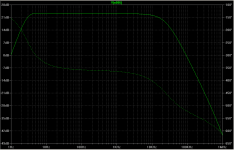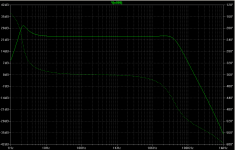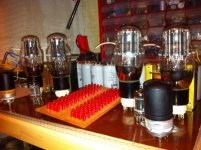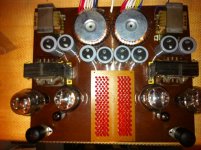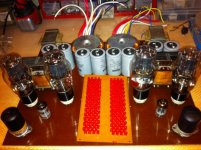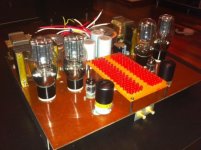I want DC couple the first stage to the LTP, which needs elevating potential on cathodes of E182CCs. Cascoded NPNs will be used. That in turn will increase CCS AC impedance 3 magnitude order (initially max. 200k).
E182CC is said to work @Ua=150V. I need 130V anode voltage swing and 150V of Ua then 120V + Ugk(E182CC) is left. Say, 126 - 134V on the anode of the first stage.
CCS impedance is *only* ~2Mohm. One order. And an echo repeated ...uck ...uck ...uck ...
ECC81 vs. 6SN7 or 6H8C
As I have Philips Miniwatt ECC81 I also simulated the circuit response with that tube as first stage.
Right one is ECC81, left one is 6H8C.
As I have Philips Miniwatt ECC81 I also simulated the circuit response with that tube as first stage.
Right one is ECC81, left one is 6H8C.
Attachments
Last edited:
Led Better Heights? Led It Be? Led'er go?.
Led Zeppelin!
Member
Joined 2009
Paid Member
Led Zeppelin!
That one is good. However I might be sued.
Hi yagoolar,
what's the purpose of using these LEDs in the cathode circuitry of your finals? In my humble opinion you pair the main disadvantages of fixed biasing (i.e. inherent possibillity of runaway due to floating mains voltage, tube deterioration etc.) with those of cathode biasing (voltage and thus power loss).
Best regards!
what's the purpose of using these LEDs in the cathode circuitry of your finals? In my humble opinion you pair the main disadvantages of fixed biasing (i.e. inherent possibillity of runaway due to floating mains voltage, tube deterioration etc.) with those of cathode biasing (voltage and thus power loss).
Best regards!
Thanks for the question. There is no straight answer to it, so a couple ones below:
1. I have 2 PSU trafos with 2x 320V winding at hand ( actually they are 230/220 x 320V, as mains voltage was raised in Poland after I had bought them. And no turning back ) - so the rectified and filtered voltage is to be around 400V DC. If I wanted to go fixed bias I should drop 50V.
) - so the rectified and filtered voltage is to be around 400V DC. If I wanted to go fixed bias I should drop 50V.
2. LED array compared to RC in the cathode has lower dynamic impedance - results in better LF response. And I have already had this array and tested it in RDL and 6C4C SE parafeed. And it suits me fine.
3. If I went into fixed bias I would need another source of voltage, i.e. another transformer or voltage multiplier plus good filtering. I wanted it simple and to finish by Christmas, yet I won't ...
4. LEDs also indicate clipping.
That is a proof of concept (PoC) and it may end up in fixed bias the other day.
"Jeśli nie wiesz dokąd zmierzasz, każda droga jest równie dobra"
1. I have 2 PSU trafos with 2x 320V winding at hand ( actually they are 230/220 x 320V, as mains voltage was raised in Poland after I had bought them. And no turning back
2. LED array compared to RC in the cathode has lower dynamic impedance - results in better LF response. And I have already had this array and tested it in RDL and 6C4C SE parafeed. And it suits me fine.
3. If I went into fixed bias I would need another source of voltage, i.e. another transformer or voltage multiplier plus good filtering. I wanted it simple and to finish by Christmas, yet I won't ...
4. LEDs also indicate clipping.
That is a proof of concept (PoC) and it may end up in fixed bias the other day.
"Jeśli nie wiesz dokąd zmierzasz, każda droga jest równie dobra"
Member
Joined 2009
Paid Member
Any progress?
I have a great sounding 6C4C PP amp playing now. It has 26 differential pair inputs direct coupled to 4P1L drivers into LL1660/PP. All DHT. If you're in Poland the 4P1L will be cheap for you. There's some threads on it on this forum. The 26 is the king of small DHTs and needs no introduction.
Andy
I have a great sounding 6C4C PP amp playing now. It has 26 differential pair inputs direct coupled to 4P1L drivers into LL1660/PP. All DHT. If you're in Poland the 4P1L will be cheap for you. There's some threads on it on this forum. The 26 is the king of small DHTs and needs no introduction.
Andy
I have never liked the sound of RC coupling the driver to power triodes like the 6C4C. Just not enough power to drive the triodes well. Have you thought about IT transformer coupling or using a cathode or a source follower to drive the triodes? Much better...
Daniel
I cannot comment about the "sound" of RC coupling; it worked perfectly well in my p-p 813 amplifier which was said to sound good.
A 6C4C/2A3/6B4G is not difficult to drive; as always it is important to choose a suitable valve and then, more important, to select a suitable operating point.
Cathode follower? For me, the best solution of all. DC-couple to the cathode follower and then you can put a pentode underneath as an active load; works very nicely indeed.
Paul
Any progress?
I have a great sounding 6C4C PP amp playing now. It has 26 differential pair inputs direct coupled to 4P1L drivers into LL1660/PP. All DHT. If you're in Poland the 4P1L will be cheap for you. There's some threads on it on this forum. The 26 is the king of small DHTs and needs no introduction.
Andy
No progress since last update, unfotunately. Now I have been rebuilding 6C4C SE parafeed - new input tube, new resistors and caps plus new power supply. LED biased of course.
- Status
- This old topic is closed. If you want to reopen this topic, contact a moderator using the "Report Post" button.
- Home
- Amplifiers
- Tubes / Valves
- 12W Push pull w/6C4C
